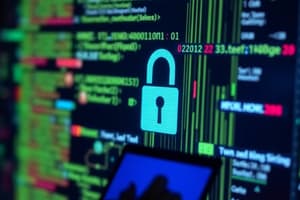Podcast
Questions and Answers
What is the goal of a Denial-of-Service (DoS) attack?
What is the goal of a Denial-of-Service (DoS) attack?
- To monitor network data exchanges
- To flood a network with more traffic than it can handle (correct)
- To modify information in the network
- To encrypt sensitive information
How does a sniffer or eavesdropper capture network data exchanges?
How does a sniffer or eavesdropper capture network data exchanges?
- By flooding the network with traffic
- By modifying the network data
- By monitoring and reading network packets (correct)
- By encrypting the network data
What are the observable signs of a Denial-of-Service (DoS) attack?
What are the observable signs of a Denial-of-Service (DoS) attack?
- Encryption of all network data exchanges
- Slow response of the server, slow network performance, unavailability of software or web page (correct)
- Rapid recovery of the server after an attack
- Frequent modification of network data
What happens if the packets captured by a sniffer are not encrypted?
What happens if the packets captured by a sniffer are not encrypted?
What can a cracker obtain if the network packets are captured using a sniffer?
What can a cracker obtain if the network packets are captured using a sniffer?
What is the goal of a Denial-of-Service (DoS) attack?
What is the goal of a Denial-of-Service (DoS) attack?
What is the observable sign of a Denial-of-Service (DoS) attack?
What is the observable sign of a Denial-of-Service (DoS) attack?
What can a cracker obtain if the network packets are captured using a sniffer?
What can a cracker obtain if the network packets are captured using a sniffer?
How does a sniffer or eavesdropper capture network data exchanges?
How does a sniffer or eavesdropper capture network data exchanges?
What happens if the packets captured by a sniffer are not encrypted?
What happens if the packets captured by a sniffer are not encrypted?
Study Notes
Denial-of-Service (DoS) Attack
- A DoS attack aims to disrupt the normal functioning of a targeted server, service, or network, rendering it unavailable to users.
- Attackers often overwhelm the target with excessive requests or consume bandwidth, exhausting resources and causing legitimate requests to be dropped.
Sniffers and Data Capture
- Sniffers or eavesdroppers capture network data exchanges by monitoring traffic on the network, accessing packets transmitted over unsecured channels.
- Techniques include placing the sniffer in promiscuous mode, allowing it to intercept and log traffic not intended for its own network interface.
Observable Signs of DoS Attack
- Symptoms of a DoS attack include a significant slowdown in network performance, inconsistent connectivity, or complete service outages.
- Users may experience unusually high response times, unresponsive applications, or inability to access websites.
Captured Packets and Encryption
- If packets captured by a sniffer are not encrypted, the data is exposed in plain text, making sensitive information easily readable.
- Unencrypted data includes usernames, passwords, and other confidential information, which can be exploited by attackers.
Data Obtained by Crackers
- A cracker can obtain critical data from captured packets, such as login credentials, session tokens, and unprotected files.
- This information can lead to unauthorized access, data breaches, and further attacks on the network.
Key Points on Sniffing Techniques
- Sniffers can be used maliciously to gather sensitive data; thus, network security must include encryption and monitoring to prevent unauthorized access.
- Effective measures against sniffing include using secure protocols like HTTPS, VPNs, and enabling strong encryption mechanisms to protect transmitted data.
Studying That Suits You
Use AI to generate personalized quizzes and flashcards to suit your learning preferences.
Description
Test your knowledge about different types of cyber attacks and protection schemes with this quiz. Learn about various attack methods such as denial-of-service and the importance of maintaining confidentiality, integrity, and availability of information.




